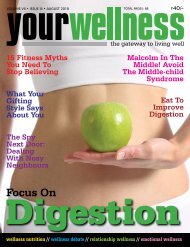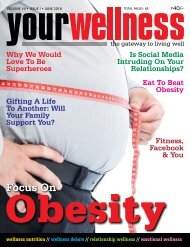YW_Issue_94_July-18_68 pages
Create successful ePaper yourself
Turn your PDF publications into a flip-book with our unique Google optimized e-Paper software.
exercise<br />
44 wellness<br />
Ways To Improve Fitness<br />
Among The Fittest<br />
Having protein regularly<br />
throughout the day (proteinpacing)<br />
combined with a multidimensional<br />
exercise regimen<br />
improves fitness among the<br />
fittest, say exercise scientists<br />
from Skidmore College, USA. The<br />
exercise regimen has to include<br />
resistance exercise, interval sprint<br />
exercise, stretching and endurance<br />
exercise. The researchers, in search<br />
of the most effective lifestyle<br />
strategies to improve health and<br />
physical performance, have found<br />
that this routine, when followed<br />
for 12 weeks or more, shows<br />
improved fitness, decreased total<br />
and abdominal fat, increased lean<br />
body mass, and optimal metabolic<br />
and heart health in people.<br />
To make the diet and exercise<br />
regimen easy for the public to<br />
remember, exercise scientist Paul<br />
Arciero has coined the acronym,<br />
‘PRISE’: P stands for proteinpacing,<br />
R stands for resistance, I<br />
stands for interval, the S stands<br />
for stretching, and the E stands for<br />
endurance.<br />
“Whether your goal is to<br />
improve fitness or heart health,<br />
the quality of your diet and a<br />
multi-dimensional exercise training<br />
regimen (PRISE) can make all the<br />
difference, says Arciero. “It’s not<br />
about simply eating less calories<br />
and doing more exercise. It’s<br />
about eating the right foods at<br />
the right time and incorporating a<br />
combination of exercises that most<br />
effectively promotes health and<br />
fitness.”<br />
The researchers enlisted 30<br />
women and 20 men between the<br />
ages of 30 and 65 who could<br />
clearly be described as being<br />
physically fit.<br />
Dividing the subjects randomly<br />
into two groups, the scientists<br />
conducted a 12-week trial in<br />
which all subjects consumed the<br />
same amount of calories and<br />
performed the identical exercise<br />
routine, but their diet quality<br />
differed. One group consumed<br />
commonly-recommended protein<br />
and fitness/sport nutrition<br />
products and the second group<br />
consumed a slightly increased<br />
protein intake and antioxidantrich<br />
supplements.<br />
When the trial ended, the<br />
researchers found that although<br />
both groups improved on nearly<br />
every measure, those who had<br />
followed the protein-pacing and<br />
antioxidant-rich diet showed<br />
the greatest improvements in<br />
fitness, including upper body<br />
muscular endurance and power,<br />
core strength, and blood vessel<br />
health (reduced artery stiffness)<br />
among female participants; and<br />
upper and lower body muscular<br />
strength and power, aerobic<br />
power, and lower back flexibility<br />
among male participants. They<br />
observed that the PRISE protocol<br />
of protein-pacing with either whole<br />
food sources or whey protein<br />
supplementation, were equally<br />
effective at improving physical<br />
fitness, as well as decreasing<br />
total, abdominal and visceral fat,<br />
increasing the proportion of lean<br />
muscle mass and significantly<br />
reducing blood glucose, insulin and<br />
cholesterol levels.<br />
Overall, the study encourages<br />
rethinking of current assumptions<br />
about diet and exercise, which<br />
place too much focus on the<br />
quantity of calories eaten and<br />
amount of exercise people do,<br />
rather than the quality of the food<br />
eaten and the exercise.<br />
yourwellness.com • Volume VII • <strong>Issue</strong> II • <strong>July</strong> 20<strong>18</strong>




